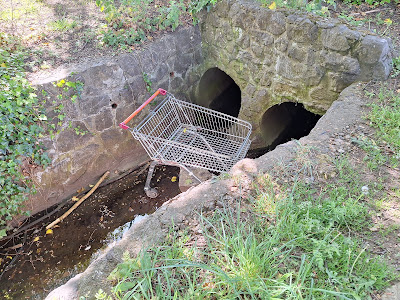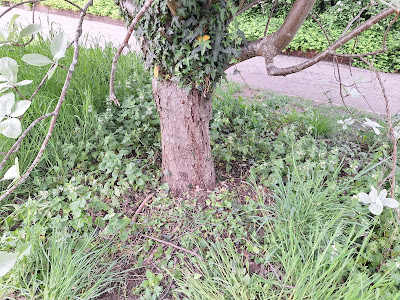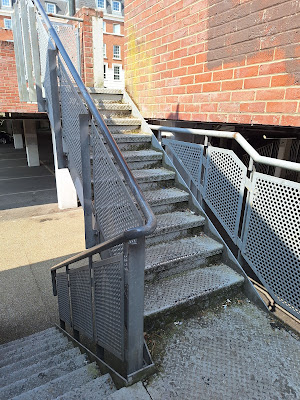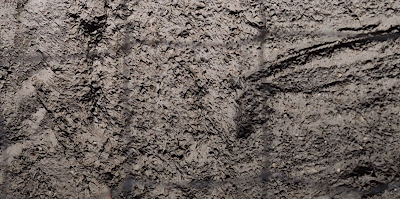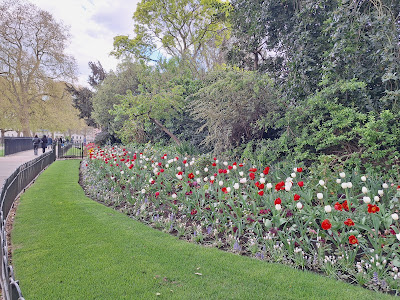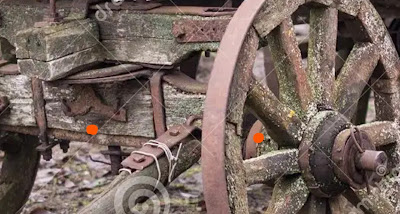As it turned out, our Easter kicked off with a short break in London, a short break which involved a short stay in the Premier Inn Hub in Tothill Street, right opposite the Caxton House where I worked in the late 1970s.
Permier Inn Hub being new for us, offering a small but decent room in the middle of London at what seemed to us to be a very reasonable rate. The size of the room was mitigated by a restaurant-lounge area on the ground floor, which seemed to be open for long hours and which offered a decent buffet-style breakfast in the morning. They also offered early check-in, which was convenient for us.
The first item on our agenda was 'The Score' at the Theatre Royal in the Haymarket, recommended by a correspondent. Brian Cox in the chair, as it were, not someone of whom I had previously heard, but he has a good long CV. And I had heard of Trevor Nunn, the director.
A bright, warm day and we were out of the house not long after 10:00, quite early for us. Met a sprightly older gentleman on Clay Hill Green, something over ninety, once a stockbroker, once a Wimbledonian and still making the odd trip into town. He seemed to know about the 'Deep Blue Sea' coming back to the Theatre Royal next month. All most impressive.
Arrived at Westminster on the Jubilee Line, something I think we have done before, but I was very impressed by the size of the cavern.
And what was I seeing at the back of the first snap? Bedrock, spray on concrete or what? My only information is that the brown London clay is quite deep, having drilled test holes in the stuff near Paddington, back in the 1960s.
A zoomed version.
Turning to my handy map of South London geology, which reaches almost to Charing Cross, I get the snap above. LC, London clay formation. LMB, Lambeth group. Blue for the Thanet sand formation. And green for the chalk underneath, starting maybe 60m down. Which is about how far down Copilot thinks that the Jubilee Line is to be found. So not much further ahead - but my bet is on spray concrete, to stabilise whatever it is underneath.
Lots of tourists and barriers above: seems a long time since I used to work there. Plus queues to be photographed in selected telephone boxes. I was pleased to see that Lime Bicycles seem to have cleaned up there act a bit, with their hire bikes being concentrated in sensible places rather than littering the pavements haphazardly. Perhaps someone told them that if they did not clean up their act, they might find themselves banned.
We took a break at the Central Hall, a place we use from time to time, offering, inter alia, interesting and rather different food, in pleasantly uncrowded surroundings. On this occasion, rather good beef sandwiches. Tea not so good, being made with the sort of tea bags which knock out the tannin very quickly. At least I think that that is what the problem is.
A place which rather reminds us of the Salvation Army canteen at the north end of the wobbling bridge which leads you up to St. Paul's. Better grub though.
A place operated by people called Green & Fortune of reference 2. People who live in the once very seedy now fully gentrified York Way, next to Kings Cross station.
We were a little sorry to learn that the operation is about to be moved up from the basement to the ground floor, presumably to make it more accessible to the many tourists passing by. We suspect that this will mean a loss of amenity as far as we are concerned, but we can also see that they need the business. Central Hall is a very big, and presumably very expensive, building.
Thus fortified, we were checked into the hub by a very cheerful young lady. No need for DIY as I had expected - and I had even armed my telephone with a QR code for the purpose. Up in the lift to the 6th floor to find that our room was indeed small, but it did have a window (we had gathered that quite a few of the rooms did not) and that it had been very cleverly designed. Fine for a short stay, or even a longer one provided you did not plan to take too many of your waking hours in it. Complete with a wall mounted bottle opener, in case of need.
The black band above the bed included a touch screen to work the lights and the heating - which took us a little while to get the hang of. While the whole thing looked pretty much brand new and my only worry was that it might not wear too well.
I imagine that the four bunked cabin I once sailed to Canada in - the Empress of Canada - would now seem a bit primitive in comparison, if roughly the same size. From reference 3, I learn that it must have been almost brand new when I travelled on it - but I don't remember it as being white or as having just the one funnel. I do remember a free cinema and a free swimming pool, this last a deep salt water pool well down inside the ship.
A short time-out, after which we strolled past the busy Westminster Arms and up Horse Guards Road, to be impressed by what look like semi-permanent structures on the parade ground, plus what looked like some fancy security box top right. Are even the Guards reduced to chasing foot-fall and bums-on-seats to make ends meet? At least we had the pleasant reminder of our days of glory, in the form of Old Admiralty, middle left, a grand building dating from the days when we had lots of battleships, but now long vacated by the admirals.
I associate now to having seen the last of them, HMS Vanguard, as a child, tied up at Portsmouth before going to the breakers' yard up north. This being, I think, before the breakers moved to Pakistan. While some years later, I became a acquainted at TB with a long-service sailor who had done time in her.
On into the Haymarket, where we came across this fine truck from Coyle Haulage delivering building materials to a site more or less opposite the theatre. Read all about them at reference 5 - where lots of impressive trucks are to be found.
The theatre seemed quite modest compared with that in nearby Drury Lane. On the other hand, we did get a proper set with walls, rooms and furniture. Clever use of the small rotating stage. A team wearing wigs and period (18th century) clothes. A proper bit of drama in fact, almost ensemble acting. Complete with someone playing a Bach cello suite from Box A in the interval, although I am not sure how many of the audience cottoned on. Boxes B, C and D appeared to be empty, although the stalls seemed pretty full.
A proper play, with real content. What is the proper way for an artist to behave when he meets a fighting soldier king, even one with artistic pretensions? Quite a big role for one of Bach's sons, more famous in his day than Bach himself, as I recall. The father's real fame came later. Casting good, including Cox's wife playing Bach's (second) wife, with none of the casting lapses that we had for both our visits to Drury Lane.
BH also turned up something that explained that Drury Lane was far too big for regular theatre, and was much better suited to spectacle. Which might explain why it was host to the 'Frozen' (of reference 6) for a long time.
Frederick the Great is to be found at reference 7, from where the extraordinary image above is taken: 'Attack of Prussian Infantry, Hohenfriedberg by Carl Röchling (1913)'. A picture which I thought I had seen before - before I found it in the programme that is - but this evening I have no idea where that might have been.
A battle which Frederick won in 1745, thus confirming his taking Silesia (including what was then called Breslau) from the Austrians. Since the Second World War, part of Poland, that is to say some 200 years later. Who would want to be one of the chaps out front? Is it any wonder that Napoleon, a general who knew about artillery, did so well against them? At least at first.
On exit, back through St. James's Park, where we were able to admire some fine tulips.
And some fine gas pipes in the gas works at the top of Tothill Streeet. Made both the holes and the pipes to be seen at Epsom of recent weeks look pretty puny.
I then managed to get into a muddle about the placement of the small spires at the corners of the west towers of Westminster Abbey, managing to convince myself that they were left aligned rather than centre aligned. BH, more impressed by the threatening sky behind, simply said that I was being silly and it was all down to point of view. She was quite right, and the spires moved back to a central position as we moved to the right of the snap above.
And so to the Munich Cricket Club, first visited one lunchtime back in August last year, as noticed at reference 8. Where, having got into a muddle about the colour of my wine on my first visit, I got into another one on this second visit, thinking that the spätburgunder in the rosé part of the wine list would be red. But it was quite drinkable.
Rather splendid potato pancakes to start, topped with a fried egg: 'Kartoffelpuffer mit Käse Zwiebeln und Spiegelei'. Followed by a huge pork knuckle which, for the first time in many a year, I was unable to finish, although I did have a pretty good go. The crackling was absolutely spot on. But I did not try the brown goo to the left. 'Geschmorte Schweinshaxe auf Sauerkraut, Knödel und Soße'.
Made the 'slow roast pork belly' they make such a big deal of in our public houses these days look a bit naff.
Getting towards the end. Getting to taste the salt.
Proceedings enlivened by various office dos, one birthday and a small but properly dressed oompah band. Much loud music, singing, standing on benches and tables. All great fun. As older people we had been sat to one side, where we could enjoy the spectacle without feeling the need to join in too vigorously.
We took a night cap in a public house called the 'Sanctuary House' in Tothill Street, one of several public houses there which I am sure were not there when I worked across the road - albeit that being more than forty years ago now. In my case, an Eclipse rum from Mount Gay, a brand that I have had a soft spot for ever since I owned one of their umbrellas, presumably the result of a visit to one of the fine car boot sales at Hook Road Arena. With this particular rum named for the 1910 total solar eclipse, visible in Barbados. BH took an Earl Grey tea.
Heritage status of the house uncertain. The brown wood looked fairly new, but the ceiling did not.
It also offered an odd print of a foot parade in Horse Guards. Not really up to the (rather later) Röchling standard - but there is clearly nothing new about doing soldiers by CGI.
PS: in the margins, I was interested to read about planning problems in Spain at reference 9. At least we are not the only people to get into a tangle about this sort of thing. The problem in question being the near finished hotel snapped above. Been like that for twenty years. The locals want it finished and put into service: never mind the environment that other people have wrecked - they want the work.
The local rules say all buildings must be white. But maybe Greenpeace, when they took to the paint pots, had not bothered to read them.
References
Reference 1: https://psmv5.blogspot.com/2025/04/piano-102.html. The duplicate piano: doesn't happen very often.
Reference 2: https://greenandfortune.co.uk/.
Reference 3: http://www.liverpoolships.org/empress_of_canada_of_1961.html.
Reference 4: https://en.wikipedia.org/wiki/Admiralty_buildings.
Reference 5: https://www.coylehaulage.uk/.
Reference 6: https://frozenthemusical.co.uk/.
Reference 7: https://en.wikipedia.org/wiki/Frederick_the_Great.
Reference 8: https://psmv5.blogspot.com/2024/08/munich-on-thames.html.
Reference 9: Spain’s huge ghost hotel — and why they can’t knock it down: The 20-storey El Algarrobico is a deserted monument to the struggle between environment and development - Henry Mance, Financial Times - 2025.






